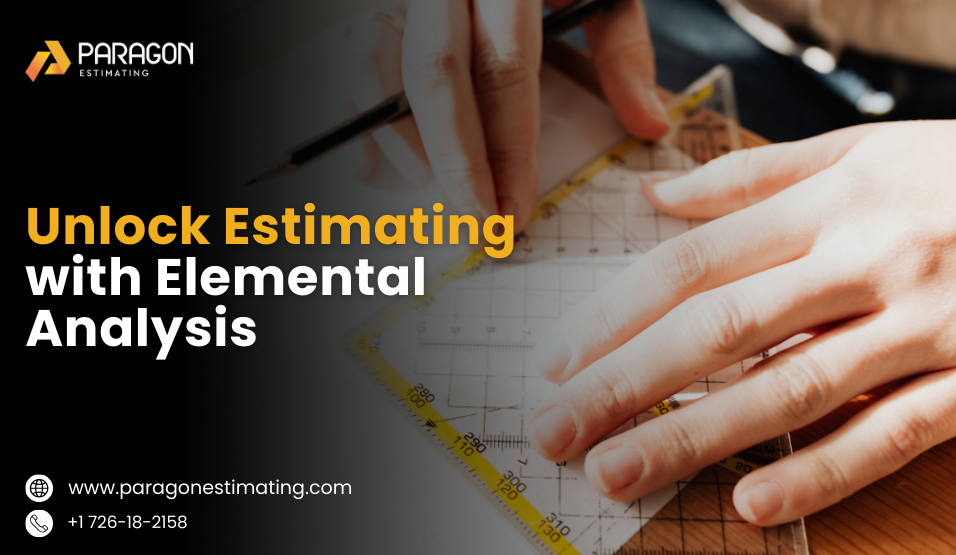The success of a building project depends critically on an awareness of where and how money is used. Elemental cost analysis is a useful approach to dividing general expenses into several areas, therefore facilitating budget management, control of expenses, and precise planning. From concept to completion, project teams can find possible savings, prevent overruns, and make wise financial decisions by closely examining cost components by element.
At Paragon Estimating, we specialize in delivering precise, transparent, and actionable cost analysis to support smarter project execution. This handbook investigates the fundamental ideas of elemental cost analysis, its benefits, and how to apply it to guarantee more accurate, open, and efficient building cost planning.
What is Elemental Cost Analysis?
Elemental cost analysis is the method of breaking out the total cost of a project into its component “elements.” Usually, these elements fit into major spending groups like labor, supplies, tools, and cost. Every element is examined separately to ascertain its cost influence on the whole project, thereby guiding project managers, estimators, and contractors in their choice of budgeting and cost control.
Why is Elemental Cost Analysis Crucial for Project Success?
Elemental cost analysis is not just another estimating tool; it’s a game-changer. It offers several key benefits that make it indispensable for successful project management:

Accurate Cost Estimation
Elemental cost analysis has as its main goal the division of expenses into reasonable, separate components. This helps to estimate costs more precisely, thereby representing the actual value of every component engaged in the project. This degree of detail is very useful in guaranteeing that you remain under budget and in avoiding cost overruns.
Better Resource Allocation
Using elemental analysis, project managers can spot places where resources might be underused or overallocated. Should materials be more costly than expected or labor expenses be greater, for instance, you might modify your strategy to better use resources to avoid running over your budget.
Enhanced Cost Control
Understanding how particular cost components affect the whole project can help you make real-time changes to control expenses. Staying on top of your money depends on this control, whether you are managing a building project or other major effort.
How to Perform Elemental Cost Analysis?
Performing elemental cost analysis is a structured process that involves several key steps. Let’s walk you through them:
Step 1: Define Your Project’s Scope
Before you can begin analyzing costs, you need to clearly define the project’s scope. What is the project’s objective? What resources will be required? By understanding the full scope, you can identify all the elements that will impact costs.
Step 2: Break Down the Project into Elements
Once the scope is defined, break the project down into smaller elements or categories. These can include:
- Labor Costs
- Material Costs
- Equipment Costs
- Overhead Costs
- Miscellaneous Costs
Step 3: Assign Costs to Each Element
Researching current market prices, looking over past data, and thinking about any elements influencing costs, such as geography or project complexity, may all help here.
Step 4: Analyze the Results
Analyze the overall expenses to see whether the budget fits the extent of the project after giving costs to every component. Should any cost components seem excessive, now is the time to search for strategies for cost-cutting without sacrificing standards of quality.
Step 5: Adjust and Reevaluate
Elemental cost analysis is not a one-time task. Projects evolve, and expenses could change, as well as new components show up. To guarantee that the project remains financially on target, you should thus often examine and change your analysis.
Key Benefits of Elemental Cost Analysis for Estimators
Increased Accuracy
Elemental cost analysis gives estimators a detailed, data-driven picture of the total cost of a project. By understanding each component, estimators can produce more precise and reliable estimates, reducing the risk of errors.
Increased Transparency
Transparency in cost estimations is much valued by clients and stakeholders. Elemental cost analysis lets you clearly, logically separate the expenses, thereby fostering confidence in your projections.
Better Making Decisions
Using a cost breakdown, estimators and decision-makers possess the required information to assess several strategies. If the cost of one piece rises, for example, you could think about changing plans or swapping materials to help offset the effect.
The Role of Technology in Elemental Cost Analysis
Software Tools and Estimating Platforms
With the rise of advanced software tools, elemental cost analysis has become more accessible and efficient. Different estimating systems can automate breaking down expenses, assigning the correct price, and performing outcome analysis. By including data from many sources in real-time, this not only saves time but also increases the accuracy of the research.
Data Analytics and Machine Learning
Modern data analytics tools and machine learning algorithms let project managers anticipate future expenses depending on past data. By seeing tendencies in past projects, these tools enable us to more precisely estimate the possible cost of every component.
Common Challenges in Elemental Cost Analysis
Though it’s a useful instrument, basic cost analysis has certain difficulties. Here are some typical problems you might run across and solutions:
Inaccurate Data
Accurate data is the backbone of elemental cost analysis. Your study will be tilted without consistent cost data for every part. Always find current, reliable data from reliable sources, contractors, and records to avoid this.
Modifying Market Conditions
Supply chains, inflation, or market demand can all affect cost components. Keep your expense data current often and change your estimations as necessary to help you control this.
Absence of Comprehensive Analysis
Getting a thorough analysis of expenses for every component can be challenging occasionally. Under such circumstances, work with a professional estimation agency such as Paragon Estimation, which specializes in thorough elemental cost analysis.
Unlock Accurate Estimating with Elemental Cost Analysis
At Paragon Estimating, we think that mastery of the art of project estimating depends on elemental cost analysis. Separating expenses into parts can help you build accurate, open, and effective budgets that maintain the direction of your project. Whether your position is contractor, estimator, or project manager, using this strategy can help you make better decisions, control costs, and have a positive result for your projects.
Get in touch with Paragon Estimating right now if you are ready to elevate your project estimating. Our knowledgeable staff is here to assist you in using elemental cost analysis on your forthcoming project. Allow us to enable the accuracy and precision required for success!

FAQs
What is the difference between elemental cost analysis and traditional cost estimating?
While elemental cost analysis divides the cost into distinct components, offering a more thorough, granular estimate that can be changed throughout the project, traditional cost estimates usually offer a one-time estimate for the entire project.
Can elemental cost analysis be used for all types of projects?
Indeed, the elemental cost study is flexible and applicable to many projects, including infrastructure development, engineering, and building. It guarantees that the budget counts every component of a project.
How often should I perform elemental cost analysis on my project?
Elemental cost analysis should ideally be conducted periodically throughout the project life. Constant study will enable you to control the budget as the project advances and expenses change.
How does elemental cost analysis affect the overall project timeline?
Utilizing effective resource allocation, elemental cost analysis helps project managers avoid budget overruns that can cause delays. Early cost identification helps to enable rapid adjustments, therefore maintaining the project on schedule and under control.
How can I get started with elemental cost analysis?
If you have never done elemental cost analysis or require aid with difficult estimates, think about consulting Paragon Estimates for professional guidance. Our areas of expertise are offering thorough cost projections and guiding clients toward the best budgeting and project results, utilizing basic cost analysis.


